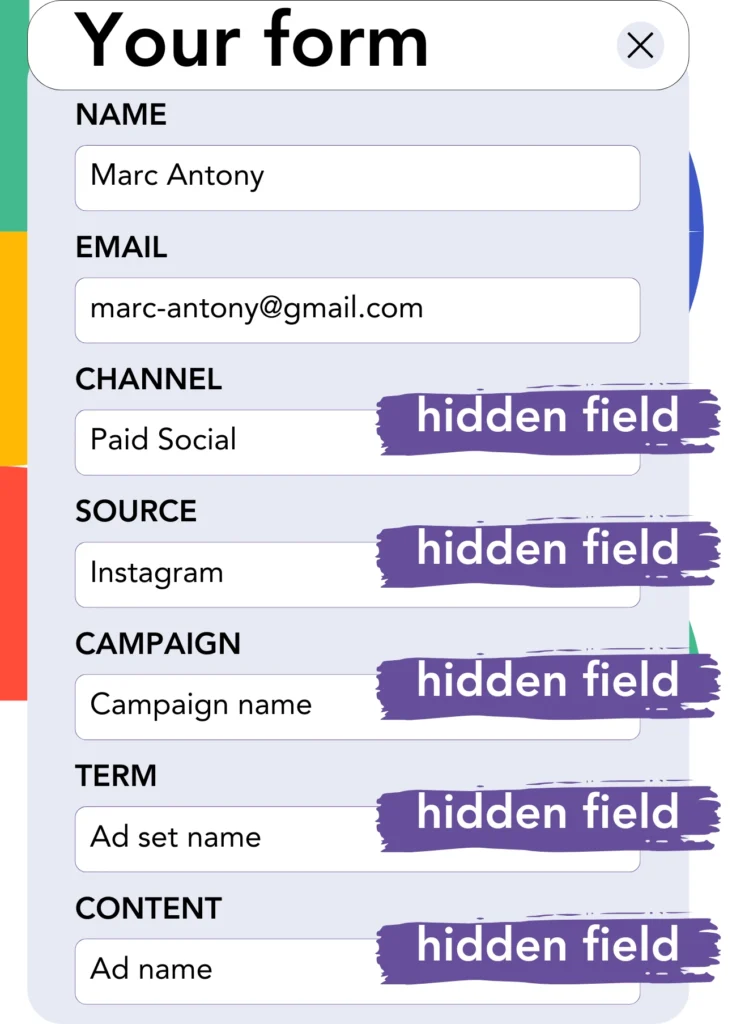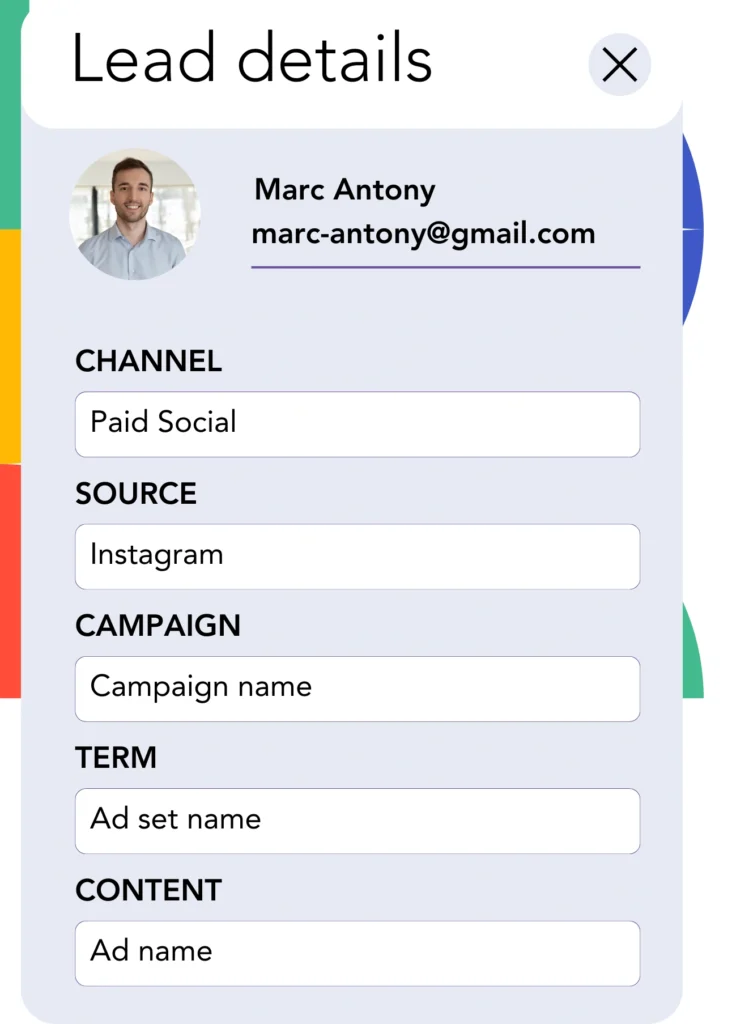Leads flow from Instagram to Pipedrive, yet there’s no way to connect each lead with a particular Instagram ad. Similarly, when leads transition into customers, you can’t determine the exact ad that generated them.
The absence of tracking prevents your ability to measure Instagram ad performance, making it unclear which ads contribute to your lead and customer growth. This could lead to spending on multiple ads without insight into their effectiveness.
Fortunately, a simple solution exists to track each lead back to the specific Instagram campaign, ad set, and ad that brought it in.
We’ll break it down step by step!
How to Track Instagram Ads in Pipedrive
Step 1: Add Leadsources in the head tag of your website

Leadsources is a simple tool that identifies your lead sources. When added to your site, it collects up to 7 types of lead source information for each new lead.
Step 2: Add the UTM parameters to your Instagram ads

Insert UTM parameters into your ad URL to track Instagram data like campaign, ad set, and ad. You can follow this format:
UTM_medium=paidsocialUTM_source=instagramUTM_campaign=campaign-nameUTM_term=ad-set-nameUTM_content=ad-name
Your final URL will resemble this:
https://www.yourdomain.com/?UTM_medium=paidsocial&UTM_source=instagram&UTM_campaign=campaign-name&UTM_term=ad-set-name&UTM_content=ad-nameImportant: Leadsources captures all lead source information, regardless of whether UTM parameters are utilized, guaranteeing full tracking for every lead.
Step 3: Add the hidden fields in your form

Hidden fields refer to form inputs that remain invisible to users while still capturing data that is submitted with the form.
The lead source data is stored in the hidden fields of your form by Leadsources. When a lead submits the form, Leadsources populates these fields with Instagram ad information automatically.
Leadsources is compatible with all widely used form builders. To learn how to add hidden fields to your form, please follow this guide.
Step 4: Capture the Instagram ads data in Pipedrive

When users engage with your ads and reach your website, Leadsources collects the Instagram campaign, ad set, and ad data, along with additional details.
The hidden fields of your form are populated with Instagram ads data by Leadsources.
Therefore, when the form is submitted, you’ll be able to see the Instagram ad data and lead details in Pipedrive (This requires that your form is connected to Pipedrive).
How does Leadsources work?
Whenever someone visits your site, Leadsources gathers Instagram ad data and populates it into the hidden fields of your form. Once the form is submitted, this information is forwarded to Pipedrive, along with the lead details you’ve captured (like name and email).
Leadsources keeps track of all the lead source information for every lead generated:
| Lead source data | Fetched automatically |
| Channel | ✅ |
| Source | ✅ |
| Campaign | ✅ OR use UTM_campaign |
| Content | UTM_content parameter is required |
| Term | UTM_term parameter is required |
| Landing page | ✅ |
| Landing page subfolder | ✅ |
The table above demonstrates that in scenarios where UTM parameters cannot be used—such as organic sources like Google search or Instagram bio links—Leadsources still retrieves some lead source data:
- Channel
- Source
- Campaign
- Landing page
- Landing page subfolder
Unlike various other tools, Leadsources keeps track of lead sources through all marketing channels, whether organic or paid.
Performance reports: Lead, sales, and revenue by source
Tracking Instagram ads data within Pipedrive allows you to produce performance reports, including:
- Leads, sales, and revenue by channel
- Leads, sales, and revenue by source
- Leads, sales, and revenue by campaign (aka. Instagram campaign)
- Leads, sales, and revenue by term (aka. Instagram ad set)
- Leads, sales, and revenue by content (aka. Instagram ad)
This enables you to adjust your Instagram budget based on the campaigns, ad sets, and ads that drive the most leads, sales, and revenue.
Let’s dive into a few of the reports you can generate:
1. Lead source reports
Compile performance reports that indicate the number of leads acquired through:
- Channel
- Source
- Campaign (aka. Instagram campaign)
- Term (aka. Instagram ad set)
- Content (aka. Instagram ad)
- Landing page
- Landing page subfolder
Example #1: Leads by channel
This report enables you to see which channel is responsible for generating the most leads.

Example #2: Leads by Instagram campaign
You are now able to focus on a specific lead source (e.g., Instagram) and evaluate the leads generated by individual Instagram campaigns.

Example #3: Leads by Instagram ad
After determining the Instagram campaign that brings in the highest number of leads, you can analyze which particular ad group or ad generates those leads.

2. Sales and revenue source reports
Having established which Instagram campaign, ad set, and ad yield our leads, we must now assess whether these leads are translating into sales and revenue.
For this purpose, connect your leads to a CRM like Pipedrive. This setup allows you to track sales and revenue produced by various channels, sources, Instagram campaigns, ad sets, ads, landing pages, and their subfolders.
Using this information, you can modify your Instagram ad approach to emphasize the channels, sources, campaigns, ad sets, and ads that produced the greatest sales and revenue.
You have the ability to create various sales and revenue reports, such as:
- Sales and revenue by channel
- Sales and revenue by source
- Sales and revenue by campaign
- Sales and revenue by term (e.g., Instagram ad set)
- Sales and revenue by content (e.g., Instagram ad)
- Sales and revenue by landing page
- Sales and revenue by landing page subfolder
Example Scenario:
| Channel | Search Paid | Social Paid |
|---|---|---|
| Leads | 50 | 75 |
| Sales | 5 | 6 |
| Average Order Value | $150 | $100 |
| Revenue | $750 | $600 |
Once the ads were launched on Google and Instagram, the first “Leads by Channel” report indicated that Social Paid ads (Instagram) yielded a greater number of leads compared to Search Paid ads.
After examining sales and revenue data in Pipedrive, you discovered that the Search Paid channel produced greater revenue with a lower number of leads compared to the Social Paid channel. As a result, you adjusted your budget to invest more in the Search Paid channel.
LeadSources tracks the source of each lead in Pipedrive, whether they come from ads, organic search, social, email, etc. and syncs that data with each submission. See the full breakdown on the lead source in Pipedrive page.

